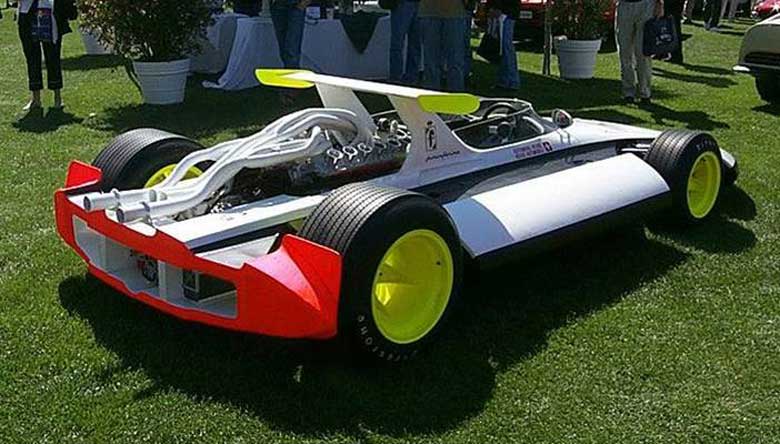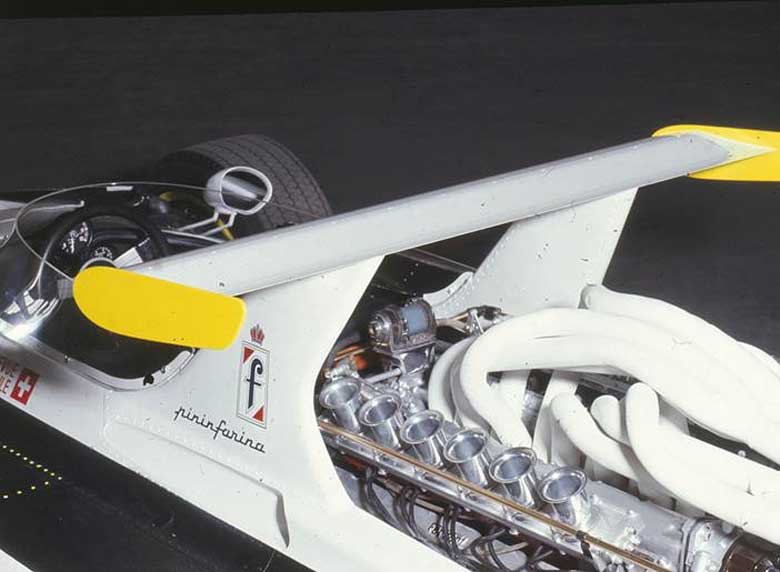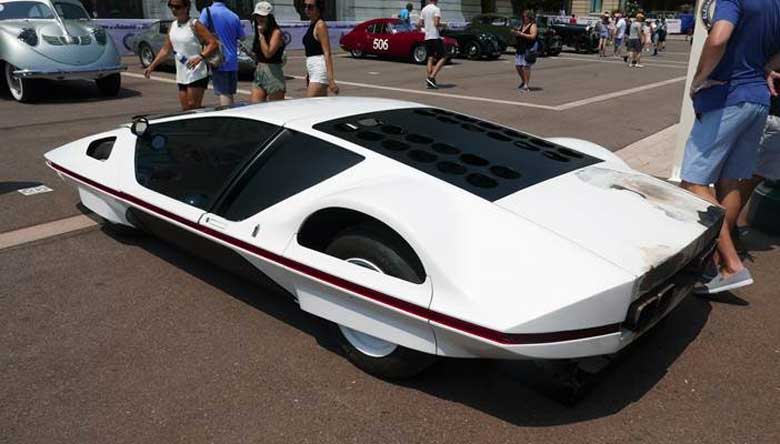
The revolutionary Sigma Grand Prix car by Pininfarina and powered by Ferrari. Note the Ferrari mag wheels. (Graham Gauld Archives.)
By Graham Gauld
“Some might feel inclined to remark, perhaps in a chiding tone, that this work has seduced us away from what has been our traditional path. We would certainly rebut such a charge.” Those words were uttered by Sergio Pininfarina when his company surprised everyone at the 1969 Geneva Motor Show by showing a startling one-off grand prix car, the Sigma.
To understand its impact, you must think back to that period in Grand Prix racing where the latest safety idea was the Armco barrier.
The great Jim Clark had been killed in a racing car just nine months before and all of a sudden Grand Prix racing realized the need for more safety. The Sigma was not Pininfarina’s idea but an idea kicked around the editorial department of the Swiss automobile magazine Revue Automobile. The journalists were mulling over the concept of a racing car with a rigid shockproof central compartment surrounded by front rear and side parts designed to collapse under severe stress and thus absorb the majority of the force of impact.
Sergio Pininfarina was clearly motivated by this and pulled together a team of people to come up with ideas for this safety Grand Prix car.
First, he called in Professor Fiala of the University of Berlin who was an expert in automobile safety. From England came Dr Michael Henderson, probably the only doctor who had carried out extensive research into the causes and effects of accidents, and probably the most influential one of all, Belgian Grand Prix driver and journalist Paul Frere who would look at the project from a drivers’ standpoint. Finally, the design of the aerodynamic shape was given to Paolo Martin.
Paolo Martin had originally joined Michelotti but stayed there just over a year before moving on to one of Ferrari’s favorite early coachbuilders, Bertone. Despite the fact this was his “day job” he was also moonlighting behind the scenes for Pininfarina so it was no surprise when he left Bertone for PF. Martin had already produced a concept car for Pininfarina based on a Ferrari; the futuristic Dino 206C “Competizione”.
Sergio Pininfarina was, however, faced with one major problem. “It quickly became clear that our project would never leave the drawing-board stage unless we had the firm backing of a racing car manufacturer.
“In view of our long co-operation and close friendship with Enzo Ferrari, therefore, we decided to inform him of our aims. He was both understanding and generous, not only in his offers of mechanical parts, such as the engine, suspension and transmission, but also in placing at our disposal his own vast experience and that of his technicians.”
The main chassis work was done by Professor Fiala but Pininfarina approached a number of companies to come up with safety ideas to be incorporated in the design. In Ferrari’s records you will find that a 312/B3 Grand Prix chassis, serial no.11, built in 1966, was assigned to Pininfarina to help with this exercise. By the end of October 1968 the design had been agreed upon and now the problem was getting the car built in time for the Geneva Show the following spring.
Dr Fiala designed two deformable longitudinal members to absorb energy in the event of a heavy impact. In the center was what Pininfarina described as a “survival cell” that had been calculated by the University of Berlin in tests taking account of the driver and the special safety belts that had been designed by Graviner.
It was estimated that the torsional stress between the two main axes of the vehicle was in the region of 700kg/per degree. At the Pininfarina factory a full-sized mock-up of the car was produced along with a quarter scale model to be used in the wind tunnel. When it came to the bodywork the object was to make it as streamlined as possible but also partially close in the wheels to avoid the situation where a car could ride up over a car in front. There was also an adjustable rear wing.
The cockpit was made larger than was normal at the time which gave the car its dumpy look and the Graviner seat belt system was a six-point full harness but with a seventh attachment to the driver’s helmet that was tested with human drivers sitting on sleds.
When it was finished the Sigma got a lot of ink in the specialist automobile magazines even though some of the safety and design ideas were already being incorporated by some of the other Grand Prix manufacturers.
This does not devalue the project and it was certainly remarkable that Enzo Ferrari would agree to offer Pininfarina virtually an entire grand prix car to work on. Once the car was finished and had been shown at Geneva it was returned to Pininfarina and has appeared at a number of shows and exhibitions since and was truly a landmark design exercise and today it is one of the star exhibits in Pininfarina’s museum.
As for Paolo Martin he designed another iconic Ferrari prototype, the 512-based Modulo, and four years later was recruited by Alessandro de Tomaso to become director of styling at Carrozzeria Ghia. Three years later and he took the familiar Italian designer route and became a freelancer working on all sorts of projects for the major manufacturers. He also branched out into speed boat design including the futuristic Quadromotorica 80 and various Magnum models, kitchenware, and motorcycles and scooters including the Gilera 125RV and the Moto Guzzi 850 Le Mans.
The verdict on the Sigma grand prix car is best left to Sergio Pininfarina himself at the time of its launch over fifty years ago. “ We feel sure that this was the first time that anyone had given any thought to the behaviour of the structure of a racing car in the event of an accident, as opposed to the problem of giving it the best size and shape to meet the stresses encountered during racing.”
Look at today’s grand prix car and the Sigma appears stone age but to those of us around at the time it gave us, and I think, the engineers and designers a lot to think about and a new way of looking at Formula 1 design.


Dr Michael Henderson is an ex-pat Brit who has lived in Australia for many years where he developed such things as the six-point harness ( an idea that came from parachutists). He is a competent historic competitor.
Looks heavy. How much did it weigh?
Thank you Graham Gauld for a glimpse of prescient thinking by PF and the experts consulted for the Sigma project.
If we sat a contemporary 1968 GP car next to this beautiful and progressive rendering, we would shudder yet again at the “accepted” disregard for the driver’s survivability during that era.
The side pods (not fuel tanks, like the 1955 Lancias) and rear wheel enclosures look to be years ahead of their time. Oddly enough, attempts to reduce the launch of the “following car” in Indy collisions, such as the Dan Wheldon tragedy, seem not to have worked well, as the massive energy of the speed differential has to go somewhere . Hence the terrifying launch of Scott Dixon’s Indy crash a few years ago, despite the rear wheel covers. Fortunately his landing was survivable due to the concept of cockpit integrity, as outlined in the Sigma experiment.
Graham very succinctly refers to the shock of Jim Clark’s accident, and how that event indirectly triggered a project like the Sigma.
What he leaves unsaid is how closely aquainted he had been with Clark personally, starting even before co-writing the 1964 Autobiography, “Jim Clark at the Wheel”, as well as several durable tributes after his accident.
Thanks again Graham, for a fine article, but I couldn’t help veering off a bit when I encounter a reference to the impact of Jim Clark.
From Graham:
Geoff:
Thank you for your kind remarks. I first met Jim Clark when he was 19 years old.
Regarding safety measures you must remember that Jackie Stewart was well into his much publicised quest to improve circuit safety by the time of Jim’s Death so the changes had started for on track safety. Indeed on the very day Jim Clark was killed Jackie was at the Jarama circuit in Spain helping the organisers regarding safety at the circuit.Also at the time Jackie Stewart started his crusade for better safety he was much maligned and he angered a lot of people but never wavered in his aims. Graham Gauld.
The Pininfarina Sigma weighed in at 590 kilos or 1300 lbs…Graham Gauld
He also wrote a booklet on motor racing safety…Graham Gauld
A great piece, Graham. It brings back a lot of memories, although it has been top of mind for a while as I recently received a significant Australian award for my work on motorsport and road safety. We had just moved out to Australia (my father’s birthplace) when I got a call from Robert Braunschweig – editor of the Swiss Automobil Revue and a friend of Sergio Pininfarina – who was bringing the team together. He had read my just-published book, Motor Racing in Safety, and asked whether I might be able to join the group. The meetings were at the Maranello factory, with many discussions in the evenings at the Real Fini in Modena. Every safety feature (but one) we put in the Sigma eventually became mandated by the FIA.